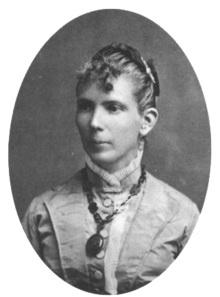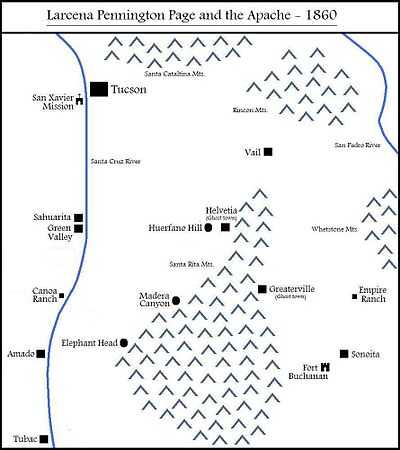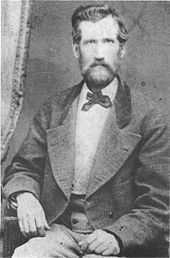Larcena Pennington Page
| Larcena Pennington Page | |
|---|---|
 | |
| Born |
Larcena Ann Pennington January 10, 1837 Nashville, Tennessee |
| Died |
March 31, 1913 Tucson, Arizona |
| Nationality |
|
| Occupation | President of the Arizona Historical Society |
Larcena Pennington Page, or Larcena Ann Pennington Page Scott, (January 10, 1837 – March 31, 1913) was a member of a well known family of American pioneers. She is most remembered for her kidnapping by hostile Apache natives in Arizona. Larcena was captured on March 16, 1860, with her young student, near Madera Canyon and left for dead later that day. She then managed to survive in the wilderness for sixteen days until finally making it to safety. After her kidnapping, Larcena was indirectly involved in several other incidents with Apaches, much of her family were either killed by the natives or died of disease.[1][2]
Early life
Born Larcena Ann Pennington, in Nashville, Tennessee, she was the daughter of Elias and Julia Ann Pennington. Her father, Elias, was the son of Elijah Pennington, a soldier who served under General George Washington at Valley Forge during the American Revolutionary War. Larcena had a total of seven sisters and four brothers. After Julia Ann Pennington died, the surviving Penningtons moved to an area near Keechi, Texas. In 1857, with the promise of economic prosperity, they traveled west, originally with the intention of settling in California. From Keechi the Penningtons headed west with three wagons, pulled by oxen and mules, and a herd of cattle. The wagon train forded the Pecos River, where several of the cows drowned, then continued on to Paso del Norte. From there they followed the Rio Grande up to Mesilla and then went west towards Tucson, passing by many prominent locations in New Mexico and Arizona history, such as Cooke's Canyon, Doubtful Canyon, San Simon Valley, Apache Pass, Sulphur Springs Valley, the San Pedro and Dragoon Springs. In June 1857, the Penningtons had to temporarily settle at Sonoita Creek, next to Fort Buchanan, because their animals were either exhausted, or had been stolen by Apaches, and Larcena had attracted malaria. The men got contracted by the government to supply the fort with hay, while the women sewed soldiers' uniforms. When the contract was finished, the Penningtons moved west to Calabasas, along the Santa Cruz River, and had taken up residence in the former home of Governor Manuel Maria Gandara by September 1859.[1]
Sometime at Fort Buchanan, Larcena met the lumberjack John Hempstead Page and fell in love. The two were married on December 24, 1859, becoming the first couple of American citizens to be wed in Tucson, which was then only a small town of a few hundred people.[1]
Kidnapping

After marriage, Larcena moved from the fort to Tucson but her husband, John, remained at Canoa Ranch, south of the present day Green Valley. Canoa Ranch was owned by John's employer, Bill Kirkland, and he lived there because it was only thirteen miles west from Madera Canyon and the Santa Rita Mountains. John and his partner, William Randall, had a small lumber mill at Madera Canyon where they would cut down pine trees and then transport them to Tucson by wagon. Larcena also worked for Kirkland, she was a teacher for his eleven-year-old ward, Mercedes Sais Quiroz. Eventually Larcena moved to Canoa Ranch with Mercedes but shortly after she became ill, possibly a recurrence of malaria. Because of this, John decided to move his wife and Mercedes out of the desert and into a cabin near the "Big Rock" at the lumber mill. It was thought that the higher elevation would help Larcena recover. On March 15, 1860, John and Randall arrived in a wagon to pick up Larcena, Mercedes and their dog for the trip to the cabin. From the ranch, the wagon headed west, through the Santa Rita foothills, towards Madera Canyon. They had nearly made it to their destination when it was decided to stop and rest for the night. The location was two miles south of the "Big Rock" and the present day Madera Kubo Gift Shop. Unbeknown to them, five Pinal Apaches were watching the camp from concealed positions in the surrounding hills. On the next morning, Randall went out to hunt for breakfast and at around 10:00 am John went up the canyon to check on a load of lumber at the mill. This left Larcena and Mercedes alone at camp with the Apaches. Larcena was sitting on a rocking chair in her tent when the dog began to bark, then suddenly she heard Mercedes scream. A moment later Mercedes was captured and the Apaches were at the door of the tent. Larcena grabbed her husband's revolver but it was taken out of her hands before she could fire it.[1][3]
The Apaches were armed with lances and bows, four were young men but the fifth was older and spoke a little Spanish. For whatever reason, the older Apache man told Mercedes that he killed John, while he drank from a nearby spring, so when the girl told Larcena she became upset and started screaming. At that point, one of the Apaches put his lance up to Larcena's breast and threatened to kill her if she would not stop. After stealing "whatever they could" and cutting open the Page's sacks of food, the Apaches took the two captives northeast, roughly along the base of the Santa Rita Mountains, towards one of their strongholds along the San Pedro River. They stopped a short distance from the camp because the Apaches wanted to tear apart a feather bed they had been trying to carry off. Larcena screamed once more and again she was told to be quiet or be killed. Robert H. Forbes, author of Penningtons: Pioneers of Early Arizona, says that up to that time neither of the captives had been molested in any way, except when the Apaches "pre-tended to ambush them from behind trees or play-fully pointed the captured pistol at them." One of the Apaches also talked about how all the land in that area was once part of their domain until the white man came. The journey to the San Pedro was rough, during the walk both Larcena and Mercedes tore off pieces of their clothing and bent twigs to make an easily recognizable trail. Forbes says; "One of the Apaches melted snow in his hands for them [the captives] to drink. Mrs. Page was pushed or pulled up steep places in the trail and Mercedes was carried pick-a-back. Their hats were restored to them from the plunder and fair progress was made...."[1][3]
Meanwhile, John, who was not actually dead, returned to the camp and found that Larcena and the girl were gone. John assumed correctly that Apaches were responsible so he found some help and followed their trail. Just before sunset, when the group was about fifteen miles from the camp, east of the present day Helvetia, one of the natives came running up and told the older Apache man that some people were approaching from behind. It was John, Randall, and a few other men from the mill. The pace quickened but Larcena could not keep up. Having walked all day and already weak from her illness, she could no longer hike up and down the steep slopes. While the group was standing atop a ridge, the Apaches made Larcena take off her corset and her skirt and then, as she turned around to continue walking, one of the natives struck her in the back with a lance and she fell over the side of the ridge, about seventeen feet, until becoming "lodged" against a pine tree. The Apaches followed Larcena down the ridge, thrusting their spears and throwing rocks at her. One of the rocks hit Larcena in the face while she was up against the tree and she went unconscious. After that, the natives dragged her body into a snow bank behind a tree, so as to not be visible from the trail, and then took her boots. Left for dead, Larcena woke up a short time later and could hear her husband's voice coming from the trail. She tried to call to him but was too weak to speak loud enough. Because one of the Apaches was now wearing Larcena's boots, John passed by his wife without ever knowing she was there and followed the Apaches' trail all the way through the Rincon Mountains and beyond the Catalina Mountains. When John was unsuccessful, he went to Tucson and recruited a posse for a second attempt at finding his wife. Another posse also formed in Tubac but it too was unsuccessful.[1][3]
After John passed by Larcena, she fell unconscious again and remained in the snow bank for about three days before waking up in the middle of the night. First she ate some snow and looked after her wounds, for she had been "bruised with stones and cut with sixteen lance wounds in her back and arms." Then Larcena went further down the ridge and fell asleep until sunrise. On the next morning, when Larcena woke up again, she began looking around to try and find out where she was. Knowing that the camp and the lumber mill were to the southeast, she looked in that direction and sighted a "small sharp-pointed hill," which has been identified as Huerfano Hill, about three miles west of Helvetia. Because of her wounds and loss of blood, Larcena could barely stand so for the next several days she crawled the fifteen miles back to camp, surviving on "seeds, herbage and wild onions, with snow water to drink." According to Forbes; "Night by night (unable to lie on her back because of her wounds) she crouched upon her knees and arms on the ground and dreamed of food; but when in her sleep she reached out for the pot of beans before her, she awoke to find her hands clutching only gravel." One day, Larcena came across a bear's nest and wanted to sleep there but she knew it was a bad idea and went away. Ten days after her "terrible journey" began, on March 26, she climbed to the top of a ridge and saw the road that leads to Madera Canyon and the camp. Hearing the sound of voices and wagon wheels, Larcena attached her petticoat to a stick to signal for help. She also screamed but the people in the wagon passed on without seeing or hearing anything. When Larcena reached the camp, two days later, she found a smoldering campfire, some flour and some coffee that was still on the ground from when the Apaches cut open the sacks of food. Using water from a nearby stream, and a piece of her clothing, Larcena prepared some bread on the fire, made some coffee, and then rested for the night.[1][3]
On the next morning, March 31, Larcena followed the road east to the "Big Rock" and lumber mill. Forbes says that "as she drew near she was seen, but not at first recognized. With clotted hair and gaping wounds, nearly naked, emaciated and sunburned, she was at first mistaken for an unfortunate outcast squaw and the men ran for their guns." It was only when Larcena called out her name that she was recognized. But even then, one man, named Smith, insisted that she was a ghost because he couldn't believe that a twenty-three-year-old women could survive so long under such trying circumstances. One of the men took Larcena into a building and had her fed and washed while another man went to get a doctor in Tucson and inform John, who was preparing for a third expedition to find his wife. On April 2, Larcena was taken to Tucson where she fully recovered under the care of Dr. C.B. Hughes. The young Mexican girl, Mercedes, was later found by the United States Army and traded for Apache prisoners at Fort Buchanan.[1][3]
Later life

In 1861 the American Civil War was about to begin and Larcena was worried that the Apaches would turn more violent with the absence of military personnel. Larcena and her family soon moved to Patagonia. Due to the Bascom Affair, Chief Cochise and Mangas Coloradas were attacking American settlements all across southern New Mexico Territory. In March or April 1861, her husband, John, was ambushed and killed by hostiles north of Tucson while transporting a wagon load of goods to Old Camp Grant. John was buried where he died, "at the top of the hill beyond Samaniego's ranch, on the old road; and all that Mrs. Page ever saw of him was his handkerchief, his purse and a lock of his hair." In the later part of August 1861, her brother, Jack, saved a fellow settler from Apaches during the Battle of Cookes Canyon.
In September, Larcena gave birth to her daughter, Mary Ann, and shortly thereafter her family moved again, to Tubac and later to a stone house along the Santa Cruz, about a half-mile from the international border with Mexico. The stone house was located in a dangerous area, infested with hostile Apaches, and at one point Larcena had to flee to Mowry, a small, fortified, mining town. Constantly moving, by April 1864, the Penningtons had gone back to Tubac and were the only residents, the rest having fled during the Apache attack in 1861. Larcena's young brothers carried very long guns, to protect the family from further attacks.[1][4][5]
Tragedy struck again in 1867 when Larcena's sister died of malaria and in 1868 her brother, Jim Pennington, was killed during a persecution of Apache. In June 1869, her father and another brother were both murdered by Apaches while working at a farm. The remaining members of the Pennington family then went to Tucson, and decided to move on to California. But, about twenty miles outside Tucson, they had to return when Larcena's sister Ellen became gravely ill with pneumonia. Despite seeking medical help, Ellen also died. After that, the only two Penningtons left were Larcena and her brother Jack. Jack moved on to Texas, but Larcena remained in Tucson.[1][4] In August 1870, she married William Fisher Scott, a Scottish lawyer and judge. Larcena and William had two children, a son and a daughter. Larcena refused to leave Arizona, despite all the hardships she went through there. Larcena became a newborn Christian and one of the first members of the Congregational Church in Tucson. She was also named president of the Arizona Historical Society. Larcena lived a relatively quiet life from then until her death.
Legacy
Pennington Street, in downtown Tucson, which is named after Larcena Pennington and her family and Scott Avenue named for her second husband William F. Scott were featured in David Leighton's popular series "Streets Smarts" in the Arizona Daily Star on Nov. 13, 2012 and Nov. 18, 2014, respectively.
In the early 2000s, a residential community named Stone House was established southeast of Sahuarita and named after the Pennington's stone house along the Santa Cruz River.[5][6][7]
References
- ↑ 1.0 1.1 1.2 1.3 1.4 1.5 1.6 1.7 1.8 1.9 "Penningtons, Pioneers of Early Arizona" (PDF). Ia7003093.us.archive.org. Retrieved 21 February 2015.
- ↑ Cleere, Jan (March 2002). "Larcena Pennington Page Survives Capture By Apaches". Chronicle of the Old West 2 (4).
- ↑ 3.0 3.1 3.2 3.3 3.4 "Larcena Pennington Page Saga" (PDF). Gvrhc.org\accessdate=21 February 2015.
- ↑ 4.0 4.1 Haskins, Cindy (2011-01-12). "Larcena Pennington (January 10, 1837-March 31, 1913) | Tubac Presidio Park". Tubacpresidiopark.wordpress.com. Retrieved 2013-10-04.
- ↑ 5.0 5.1 "Stone House - A Custom Lot and Custom Home Community in Tucson, Arizona". Stonehouseaz.com. Retrieved 2014-04-25.
- ↑ "Stone House - A Custom Lot and Custom Home Community in Tucson, Arizona". Stonehouseaz.com. Retrieved 2014-04-25.
- ↑ Leighton, David, "Pennington named for early family in territory," Arizona Daily Star, Nov. 13, 2012
Bibliography
- Banks, Leo. 'Stalwart Women: Frontier Stories of Indomitable Spirit'. ISBN 0-916179-77-X.